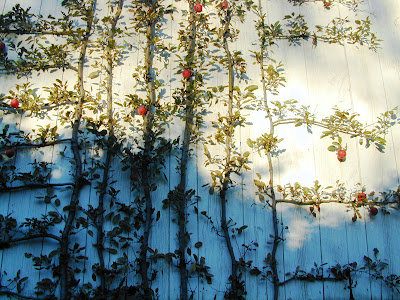
This is another moment when, through a sterling combination of impressive seasonal showmanship and tried and true performance, we are compelled to swoon over a particular genus of plant. At this time of year, when we’re awfully happy for any sustaining blossom, our vote goes to that gorgeous autumnal garden stalwart, the hydrangea, so here we will stop to laud a few varieties that have worked well for us on the farm. Probably the world’s most popular hydrangea is the “PeeGee”, correctly Hydrangea paniculata ‘Grandiflora’, which can grow to a spectacular nine feet tall, although ours are grafted as standards onto some accommodating rootstock and stand sentinel in a group of six around our pool. The name "paniculata" comes from the fact that the blooms are cone rather than ball-shaped, ‘Grandiflora’, of course, signifying extremely impressive ten inch panicles of white/green aging to rusty-tipped splendor. Also notable is the brawny Hydrangea paniculata ‘Tardiva’: we have planted an allee of them, interspersed with white pines, caryopteris ‘Longwood Blue’ and bordered with yellow-blooming potentilla, up above our pool garden, and they never fail to impress. All of the paniculatas are nicely hardy to Zone 3, may be pruned anytime save when they begin forming blossoms in summer, and, unlike many hydrangeas, can take a full day of sun if they get adequate moisture.

The hydrangea we most identify with summer, seen in our mind’s eye banking white clapboard houses with blue clouds of blossom amidst emerald lawns, are the lovely white, pink, or blue “mopheads” and “lacecaps” of the species Hydrangea macrophylla (“big-leaved hydrangea”). Some of the varieties that have worked well for us, all being small, deciduous shrubs hardy to minus twenty degrees, are the “mopheads” ‘Ami Pasquier,’ ‘Hamburg‘, ‘Nigra‘, and ‘Nikko Blue‘, and the “lacecaps” ‘Blue Wave‘, ‘Geoffrey Chadbund‘, ‘Mariesii‘, and ‘White Wave‘. Another valuable hydrangea variety is the laudable quercifolia or “Oakleaf” Hydrangea, as its large, deeply lobed leaves resemble those of the oak, which we have used in combination with magnolias and shrub chestnuts (aesculus parviflora) on the southern bank of the big pond.

An all season stunner, the quercifolia’s cinnamon-colored bark lights up the winter landscape as surely as the red or yellow whips of a witch hazel, then is followed by richly textured, bright green leaves green in spring, huge, conical heads of brilliant white florets in summer, and, finally, as autumn arrives, a dazzling show of red, orange, and maroon foliage. 'Snowflake' is probably the most popular variety, with its impressive size, and large pale green flowers turning to white, then gradually fading to a lovely rosy pink. Also nicely hardy through Zone 4b/5a. And finally, let us recommend the fantastic climbing hydrangea Hydrangea anomala petiolaris, which currently decorates the side of one of our barns. Although a bit slow to acclimate, this rangy, hardy to Zone 4 rambler will cling handily to eventually cover a wall with bright, cinnamon-colored branches, handsome shiny green foliage, and gorgeous white blossoms blooming in mid-June.

Let us deal here with the idea of changing a given hydrangea cultivar’s color from pink to blue or visa versa. First of all, yes, it is possible, although it is much easier to change a hydrangea from pink to blue than it is from blue to pink, and one cannot change a white hydrangea at all. Changing a hydrangea from pink to blue entails adding aluminum to the soil; moving the color dial from blue to pink requires the reverse i.e. the subtraction of aluminum from the soil. To get one of those marvelous deep blue types, simply apply a solution of 1 teaspoon of aluminum sulfate per gallon of water to plants throughout the growing season, taking care not to burn the roots. However, to insure that the aluminum is made available to the plant, it is important that the pH of the soil be lower than 5.5: the lower the pH, the bluer the flowers. Plants grown in soil with a pH level higher than 7 may also lack iron, and iron may need to be added in some dosage as well.

Also, a final word on cutting hydrangea blossoms for drying, which is just the thing to do this month. Don’t do it at the height of their color: fresh, recently opened blooms, rarely dry well in the open air. Hydrangeas do best when allowed to dry a bit on the plant before picking, so try harvesting right now when the petals have begun to take on a vintage look. As well, if left on the shrub a bit longer, many blooms will take on interesting shades of burgundy and pink in the bargain. Picked at the correct moment (why not today?), these stately dried blossoms will provide a handsome decorative statement in your home right through till spring.































